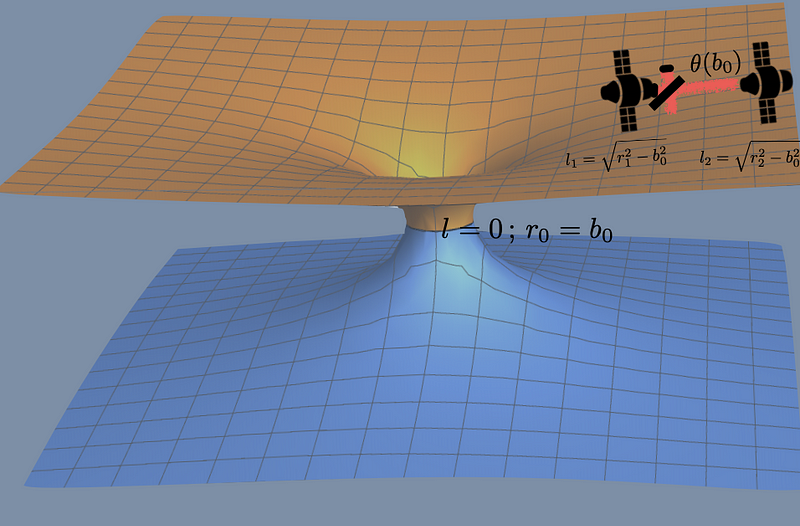Finding Wormholes in the Universe: What Lies Beyond Black Holes?
Written on
Chapter 1: The Elusive Nature of Wormholes
What if the gravitational waves we've detected aren't merely the result of merging black holes? Recent advancements in technology have prompted scientists to reconsider these cosmic phenomena.
A simulation vividly illustrates how Earth might appear distorted when viewed from the entry point of a wormhole. The images above depict a mirrored version of our planet as it exits the wormhole's throat.
Last winter, the LIGO detectors situated in the snowy landscapes of Washington and Louisiana were enhanced with a device known as a squeezed light device. This sophisticated piece of technology, encased in a hefty box reminiscent of an old computer monitor, incorporates intricate wiring and is designed to manage quantum fluctuations in the vacuum of space. Researchers donned clean suits and masks, revealing only their eyes, as they carefully installed this component. The squeezed light device plays a crucial role in controlling the quantum noise that interferes with photon travel times within the sprawling LIGO facilities. These travel times ultimately signal the detection of gravitational waves, marking a significant upgrade for the observatories.

The Virgo interferometer in Italy, similar to its US counterparts, also received a significant upgrade. This advancement exemplifies the principles of quantum metrology, where quanta—tiny packets of energy—are utilized to enhance measurement precision and accuracy, reducing statistical errors in research. Beyond their practical applications, quantum phenomena may hold the key to uncovering extraordinary cosmic entities that tend to elude detection. We often fantasize about these connections—bridges linking different spaces, times, or even universes. Although we have yet to find concrete evidence of wormholes, they remain a plausible solution to Einstein's equations.
Interestingly, wormholes can masquerade as supermassive black holes at the centers of distant galaxies or even as Sagittarius A*, the black hole in our own galaxy. A 2016 peer-reviewed study suggested that wormholes could be the source of the gravitational waves captured by LIGO, sending ripples through spacetime that eventually reach our planet. Unbeknownst to us, these gravitational wave detections could be attributed to colliding wormholes rather than merging black holes. The only distinction between the two scenarios lies in the ringdown phase, where the two entities settle into a unified state. Unfortunately, LIGO's initial detection—its most powerful signal to date—lacked sufficient ringdown data to clarify its origin.
Another theoretical construct that could imitate a black hole is the gravastar, a dense star composed of exotic matter that lacks an event horizon. Without an event horizon, gravitational waves can bounce off a gravastar, similar to how they might interact with a wormhole or any compact object. These entities, acting as cosmic chambers, would reflect gravitational waves like an echo.

Moreover, a 2017 study proposed an intriguing scenario involving two satellites positioned at a distance in flat space. A laser beam traveling between them could be influenced by the presence of a wormhole, altering measurements of the distance traveled. The degree of this effect would depend on the wormhole's radius and its specific location relative to the satellites, potentially leading to detectable phase changes in the light.
Researchers argue that advancements in technology should encourage us to explore our most outlandish theories. If we can detect monumental cosmic events from afar, we should also seek to validate or refute more speculative ideas, such as faster-than-light particles or the fantastical journeys through wormholes.
As we search for these elusive entities, one star captures our attention. It orbits the supermassive black hole at the Milky Way's center, with recent research suggesting it could be indicative of a nearby wormhole. What if Sagittarius A* conceals a wormhole due to its extreme gravitational conditions? The orbit of star S2 might exhibit deviations influenced by stars located at the other end of the wormhole. This gravitational interaction could result in observable changes in S2's behavior, with its own gravity affecting those foreign stars. In the coming decades, advancements in tracking technology may reveal anomalies in the orbit of this fiery celestial body.

Wormholes are as fragile as they are fascinating. The likelihood of successfully traversing one is slim, as even the slightest attempt to transfer information could cause it to collapse. Our hopes hinge on discovering exotic matter with repulsive energy to keep such passages stable.
However, merely gaining insight into a wormhole would be astonishing, as it would suggest a connection between disparate moments in time or entirely different realms of space. This revelation would challenge our understanding of causality and the sequence of events in our lives, raising questions about the accessibility of our past and future. If a parallel universe exists at the other end of such a bridge, the implications become even more intricate. We often fantasize about journeying through these portals to uncover uncharted territories. Yet, simply confirming the existence of a wormhole would fundamentally transform our perceptions of reality.
Chapter 2: Theoretical Implications and Future Discoveries
This video, titled "Wormholes Explained – Breaking Spacetime," delves into the intricate concepts surrounding wormholes and their potential implications for our understanding of the universe.
In this video, "Wormholes May Be Everywhere And Ways To Find Them," experts discuss the possibility of wormholes existing all around us and explore methodologies for detecting them.